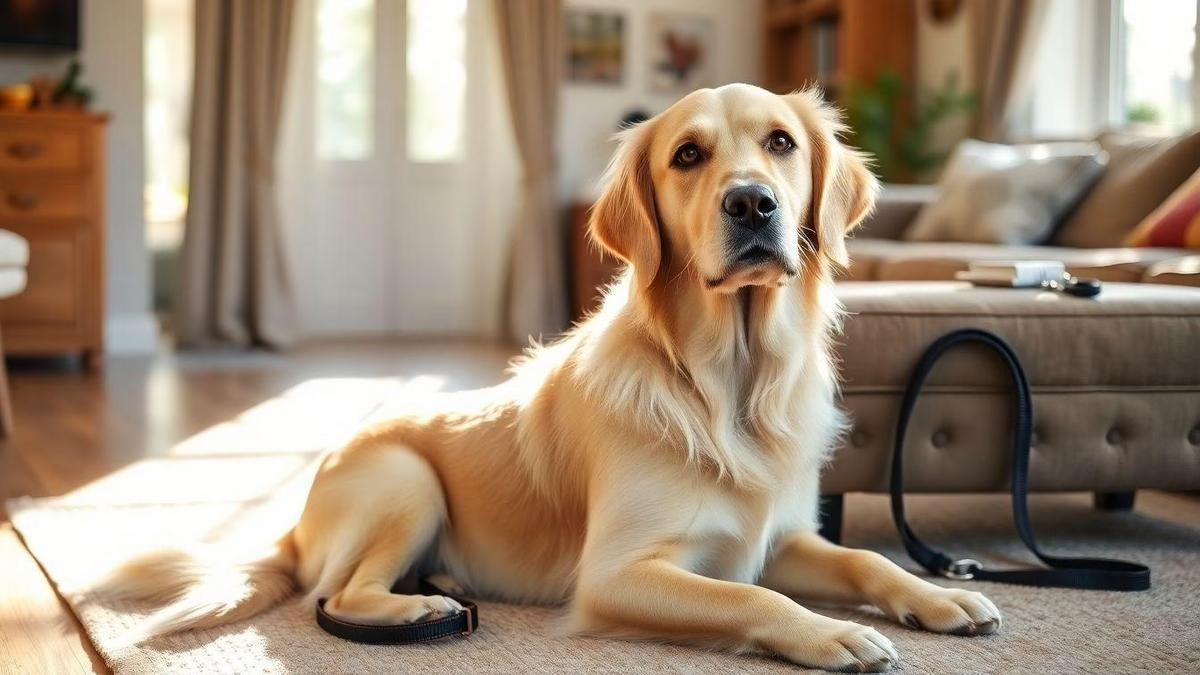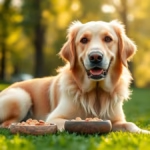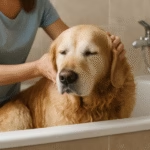Reinforcing Good Manners in Senior Golden Retrievers is about how I keep my aging dog calm, safe, and polite. I use positive reinforcement for senior Goldens with treats and praise, timing rewards right after the good action. I follow a step-by-step reward plan and keep sessions short to match my dog’s energy. I use a soft voice, hand signals, and low-impact cues, and I swap jumps for low steps and target training to protect joints. I build consistency with fixed times for walks, meals, and training, and I keep housetraining and bathroom routines simple. On leash I teach gentle walking by stopping and rewarding when my dog looks at me, and I use short leash exercises to protect joints. I watch for pain, consult my vet, and add simple cognitive enrichment like puzzle toys, scent games, and short memory drills to keep manners sharp and training fun while I track progress.
Key Takeaway
- I use short, gentle training sessions
- I reward calm behavior with soft treats and praise
- I keep commands simple and always the same
- I adjust activities for my dog’s comfort and joints
- I stay patient and keep a steady routine
Reinforcing Good Manners in Senior Golden Retrievers: how I use positive reinforcement
I learned early that older Goldens respond to kindness more than force. My boy, Max, taught me this after a bad hip day when yelling only scared him. I switched to short, calm training moments with soft rewards. Reinforcing Good Manners in Senior Golden Retrievers became a gentle habit: tiny treats, a warm tone, and lots of patience.
I keep sessions brief—two to five minutes—so Max doesn’t tire and pick moments he’s already calm (after a slow walk or settling by my chair). I pair a quiet good boy or a quick Yes! with a tiny bite, a slow scratch behind the ear, or a soft pat so he links the action to the reward without getting overexcited.
I watch his body for stiff joints or cloudy eyes and lower intensity when needed. When movement is limited, I reward cues he can still do—eye contact or a gentle sit. Steady, small steps build confidence and make training a happy part of our day.
I reward calm behavior with treats and praise
Calm behavior means no jumping, soft greetings, and relaxed lying down. When Max stays composed at the door or greets someone without bouncing, I catch that moment and offer a tiny low‑calorie treat plus soft praise. I avoid large rewards that spark frantic excitement and break treats into tiny pieces so one treat lasts many repetitions. Sometimes I swap a treat for extra pets or a favorite toy so calm itself becomes its own reward.
I time rewards right after the good action
Timing is everything. I mark the calm action with Yes! or a click, then give the treat immediately so Max knows what earned it. After marking and rewarding consistently, I slowly shift from treats to praise and touch so the behavior sticks even when snacks aren’t handy.
Step-by-step reward plan I follow
I use short steps and keep them consistent so Max knows what to expect:
- Notice the tiny calm cue (soft eyes, sitting without leaning)
- Mark it immediately with Yes! or a click
- Give a very small treat and say a warm phrase
- Pet or briefly play to reinforce social reward
- Repeat in short bursts throughout the day
- Gradually replace treats with praise and touch, keeping timing sharp
For additional ideas on structured approaches, I lean on proven behavior training techniques for senior Goldens that favor repetition, short sessions, and high-value marking.
Reward types:
| Reward type | When I use it | Why it works |
|---|---|---|
| Tiny low‑cal treat | During learning sessions and repeated reps | Fast, clear reinforcement without overeating |
| Soft cheese or special bite | For stubborn cues | High value motivator used sparingly |
| Praise petting | After behavior is reliable | Social reward that keeps the bond strong |
Gentle, age-appropriate training techniques I use for my aging Golden Retriever
I treat training like a slow, steady stroll rather than a race. Reinforcing Good Manners in Senior Golden Retrievers means short cues, clear signals, and a pace that fits his energy and joints. I reward calm choices more than flashy tricks and blend training into daily life so learning feels natural.
I watch his body language closely—if his tail drops or he yawns, I stop and switch to petting or a gentler game. That respect keeps him willing and happy and strengthens our bond.
I keep sessions short to match my dog’s energy
Five to ten minutes, two or three times a day, works like a charm. I time sessions after light walks or naps, when he’s calm and ready to learn. If I see stiffness or slower reactions, I stop and try again later.
Practical tips:
- Keep sessions 5–10 minutes; finish while he’s still interested
- Use a warm‑up like a slow walk or gentle stretch
- Repeat short sessions across the day rather than one long push
I use soft voice, hand signals, and low-impact cues
A calm tone plus clear hand signals helps when hearing fades. Touch can be a cue too: a light tap on the hip for sit, a gentle lift for paw. I avoid jerks on the leash and use harnesses that spread pressure. Slow, simple cues protect his joints and keep him confident. For step-by-step guidance on adapting cues, see advice on how to train your senior Golden.
Mobility-friendly obedience exercises I adapt
| Exercise | How I adapt it | Benefit |
|---|---|---|
| Sit-to-stand | Use a soft, non-slip mat and a low platform; cue with treat at hip level | Builds hind leg strength with low strain |
| Target touching | Teach nose or paw to touch a flat target on the floor | Improves focus and balance without jumping |
| Slow figure-8 walks | Walk around cones/pillows at a slow pace | Keeps coordination and core muscles active |
When stiffness or arthritis is a factor, I use low-impact exercises for Goldens with arthritis to protect joints while keeping muscles active.
How I build consistency and routine to support senior dog manners
A steady routine calms my old Golden. When I began Reinforcing Good Manners in Senior Golden Retrievers, I noticed he relaxed on days with a clear plan. Predictability reduces accidents and stress and helps polite behavior stick.
My daily skeleton: wake, potty, short walk, breakfast, rest, light training, nap, evening walk, dinner, quiet time. I tweak the routine when he needs extra rest but keep the core the same so he knows what to expect.
I set fixed times for walks, meals, and training
Regular timing lets his body clock help me. Training happens right after a walk when he’s alert but calm. A simple chart helps guests and family follow the plan so everyone gives the same cues.
Typical routine:
| Time of Day | Activity |
|---|---|
| 7:00 AM | Potty, 10–15 min walk |
| 8:00 AM | Breakfast, calm time |
| 12:30 PM | Short potty break / gentle play |
| 4:00 PM | Short training session (5–10 min) |
| 6:00 PM | Longer evening walk |
| 7:00 PM | Dinner, quiet wind-down |
I follow ideas from resources on creating a healthy routine for senior Goldens and tailor them to energy and mobility.
I use the same cues so my dog understands quickly
I favor short, consistent cues: sit now, wait, and bed time. Saying them the same way every time reduces confusion and keeps manners high. I reward small wins immediately with a soft good and a tiny treat or pet.
Common cues:
- Sit now — short, firm cue for immediate sitting
- Wait — for doors, gates, or food bowls
- Bed time — to move to his mat calmly
Housetraining and bathroom routines
I take him out first thing and after meals, praise every successful spot, and watch for signals like sniffing or circling. On slower days I offer more frequent short trips so he doesn’t feel pressured; consistency plus patience fixes most slip‑ups. For more structured daily patterns, see suggestions on daily routines that senior Goldens appreciate.
Reward-based behavior reinforcement and leash manners I practice
My old Golden responds to kindness more than corrections. With age, his hearing and patience changed, so I swapped long lectures for quick treats and praise. Short, frequent practice fits his energy and makes walks calmer.
I use treats to teach gentle leash walking and attention
I pick soft, small treats that are easy to chew and low in calories. I hold a treat near my leg to lure him to walk beside me, then reward the moment he stays close. Calm attention becomes its own reward.
I stop and reward when my dog looks at me, not pulls
When he pulls, I stop—no drama, no leash yank—then mark and reward when he checks back. If pulling continues, I change direction or step back to reset his focus. Over time he offered eye contact more than lunges.
Short leash exercises to protect joints and reinforce manners
- Warm up with slow sniffing for 2–3 minutes
- Walk close to my side for 10–20 steps, then stop and reward
- Ask for a sit, reward, then change direction gently
- End with a short pet and a treat, then a slow cool-down walk
Short-leash work pairs well with guidelines on safe and beneficial exercises for senior Goldens so I keep impact low and confidence high.
Managing arthritis and physical limits during obedience training
When planning a session I remind myself: Reinforcing Good Manners in Senior Golden Retrievers means picking gentle exercises and celebrating short wins. I favor mental games, scent work, and slow shaping that use his brain more than his joints.
I make the space safer—rugs, ramps, and low platforms replace slick floors and high jumps—so training stays part of life without strain. For home adaptations I referred to tips on setting up a senior-friendly home and practical advice about choosing supportive beds from how to choose the perfect bed for a senior Golden.
I replace jumps with low steps and target training
I swap high jumps for low, steady steps and target work on a mat or small platform. Targeting—nose or paw touches—builds focus and movement with much less impact than jumping.
Starter sequence:
- Place a soft target mat and reward nose touches
- Use a low step (6–8 inches) for step-ups and step-downs
- Practice short targeting sequences, then add a sit or a turn
- Walk a slow pole line to improve balance
For further options on joint-safe movement, I check resources about low-impact exercises for Goldens with arthritis.
I watch for pain signs and shorten sessions when needed
I check for limp, slower starts, longer rests, or changes in behavior. If he shows pain, I cut the session or switch to a calm nose game. Short sessions with lots of breaks keep training fun, not taxing.
When I consult the vet and modify exercises
I talk with our vet before changing routines. The vet may suggest limits, supplements, or therapies like hydrotherapy. With that input I tweak exercises and pace to keep my Golden moving well and feeling loved.
Cognitive enrichment I use for reinforcing good manners in senior dogs
For Buddy, my other Golden, Reinforcing Good Manners in Senior Golden Retrievers meant swapping long drills for five-minute brain games. Short cognitive tasks keep his mind sharp and curb bored behaviors.
I choose scent work, low-effort puzzles, and cue refreshers using hand signals. Each game targets calm attention, a reliable sit, or a gentle recall so progress is easy to spot and celebrate.
I give simple puzzle toys and scent games to keep focus
Rotate two or three easy puzzle toys so they feel fresh. A snuffle mat, a low-difficulty food puzzle, and folded-towel hides work well. Scent games are gentle on joints and big on payoff—play for 5–10 minutes, two or three times a day.
For toy ideas and age-appropriate enrichment, I use guides on appropriate toys to stimulate senior Goldens and a list of mental enrichment activities for senior Goldens.
Tip: hide a treat under an easy cover, let your dog find it, then slowly increase difficulty over days.
I practice short memory drills to strengthen cues
Run two- to three-minute drills to refresh sit, name attention, and gentle wait. Use a soft voice, a hand signal, and a tiny treat. Repeat cues in different locations (kitchen, hallway, door) so manners generalize across the home.
How I track progress and keep training fun
I keep a simple log in my phone: date, activity, time, and one sentence on mood or change. Short video clips are even better—they show whether his sit is deeper or recall faster. I vary rewards—treats, scratches, a favorite toy—to keep motivation high.
Progress sample:
| Metric | Baseline | Current | Note |
|---|---|---|---|
| Sit duration | 2 sec | 6 sec | Improved with hand signal |
| Calm at door | Jumpy | Paw on floor | Use wait cue and high‑value treat |
| Scent game focus | 1 min | 4 min | Rotate puzzles to maintain interest |
For inspiration on strengthening your relationship through training and play, see ideas about building a stronger bond with your senior Golden.
Conclusion
Gentle, steady care wins. I rely on positive reinforcement, short sessions, and a consistent routine to keep my senior Golden calm, safe, and polite. Little rewards, a soft voice, and joint‑safe exercises are my toolbox. Slow and steady, not loud and fast.
I watch his body like a weather vane—if I see stiffness or discomfort I pause, consult the vet, and switch to mental games or gentler cues. I track small gains, celebrate tiny victories, and trade heavy treats for pets and praise as behaviors stick. That keeps training feel like a warm conversation, not a chore.
In the end it’s about patience, predictability, and keeping joy at the center. Train a minute. Love a lot. If you want more practical tips and friendly inspiration, read more at gentle training methods and patience for senior Goldens.

Rafael Souza is a digital marketing strategist and lifelong dog enthusiast. Passionate about Golden Retrievers, he shares practical, research-based tips to help owners provide healthier and happier lives for their furry companions.





